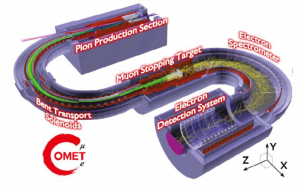COMET
COherent Muon to Electron Transition
In parallel to the direct searches for new physics currently underway at the high-energy frontier (LHC and future colliders), several experiments are searching for signals beyond the Standard Model at the high-intensity frontier. The charged lepton flavour violation (cLFV) appears to be a clear signal of the existence of new physics beyond the standard model. The objective of the COMET (COherent Muon to Electron Transition) experiment, at J-PARC in JAPAN, is the demonstration of this lepton flavour violation from a rare signal coming from the conversion of muon to electron in the vicinity of an aluminum nucleus.
COMET is an international collaboration of more than 200 collaborators from 41 institutes and 17 countries. The spokesperson for this experiment is Yoshitaka Kuno of the Department of Physics at Osaka University in Japan. The experiment is planned to take place in two phases. Phase 1 is scheduled to start in 2020. In France, the COMET-France collaboration gathers physicists and engineers from 5 IN2P3/CNRS laboratories: LPNHE at Jussieu, LPC Clermont, IPN Lyon, the IN2P3 computing center at Villeurbanne and LPC Caen.
The LPC Caen is a stakeholder in this project, particularly through its contribution to the Monte Carlo type simulations to know with precision the flux and the energy spectrum of the different particles produced during the experiment, allowing to estimate the doses received and thus the resistance to irradiation of all the components of the experimental devices present under the particle flux.

Read more
-
COMET - A submission to the 2020 update of the European Strategy for Particle Physics on behalf of the COMET collaborationCOMET - A submission to the 2020 update of the European Strategy for Particle Physics on behalf of the COMET collaboration
-
COMET Phase-I Technical Design ReportCOMET Phase-I Technical Design Report
-
COMET PublicationsCOMET Publications
-
Charged Lepton Flavour Violation using Intense Muon Beams at Future FacilitiesCharged Lepton Flavour Violation using Intense Muon Beams at Future Facilities